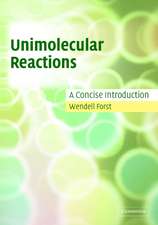Quantum Chemistry: The Challenge of Transition Metals and Coordination Chemistry: Nato Science Series C:, cartea 176
Editat de A. Veillarden Limba Engleză Hardback – 31 mai 1986
| Toate formatele și edițiile | Preț | Express |
|---|---|---|
| Paperback (1) | 1228.47 lei 6-8 săpt. | |
| SPRINGER NETHERLANDS – 26 sep 2011 | 1228.47 lei 6-8 săpt. | |
| Hardback (1) | 1234.77 lei 6-8 săpt. | |
| SPRINGER NETHERLANDS – 31 mai 1986 | 1234.77 lei 6-8 săpt. |
Din seria Nato Science Series C:
- 24%
 Preț: 797.69 lei
Preț: 797.69 lei - 18%
 Preț: 957.62 lei
Preț: 957.62 lei - 18%
 Preț: 957.13 lei
Preț: 957.13 lei - 18%
 Preț: 1227.52 lei
Preț: 1227.52 lei -
 Preț: 396.40 lei
Preț: 396.40 lei -
 Preț: 403.75 lei
Preț: 403.75 lei - 18%
 Preț: 1239.37 lei
Preț: 1239.37 lei - 18%
 Preț: 1236.51 lei
Preț: 1236.51 lei - 18%
 Preț: 1231.78 lei
Preț: 1231.78 lei - 18%
 Preț: 1229.10 lei
Preț: 1229.10 lei - 18%
 Preț: 1835.21 lei
Preț: 1835.21 lei - 24%
 Preț: 1076.39 lei
Preț: 1076.39 lei -
 Preț: 390.46 lei
Preț: 390.46 lei -
 Preț: 369.63 lei
Preț: 369.63 lei - 18%
 Preț: 1232.41 lei
Preț: 1232.41 lei -
 Preț: 394.51 lei
Preț: 394.51 lei - 18%
 Preț: 1226.24 lei
Preț: 1226.24 lei - 18%
 Preț: 1845.80 lei
Preț: 1845.80 lei -
 Preț: 399.88 lei
Preț: 399.88 lei -
 Preț: 384.28 lei
Preț: 384.28 lei -
 Preț: 390.88 lei
Preț: 390.88 lei -
 Preț: 381.19 lei
Preț: 381.19 lei - 18%
 Preț: 1848.64 lei
Preț: 1848.64 lei - 18%
 Preț: 951.14 lei
Preț: 951.14 lei - 18%
 Preț: 1230.35 lei
Preț: 1230.35 lei - 18%
 Preț: 1236.51 lei
Preț: 1236.51 lei -
 Preț: 401.03 lei
Preț: 401.03 lei -
 Preț: 406.25 lei
Preț: 406.25 lei - 18%
 Preț: 1230.84 lei
Preț: 1230.84 lei -
 Preț: 418.34 lei
Preț: 418.34 lei - 18%
 Preț: 1223.74 lei
Preț: 1223.74 lei
Preț: 1234.77 lei
Preț vechi: 1505.82 lei
-18% Nou
Puncte Express: 1852
Preț estimativ în valută:
236.27€ • 257.45$ • 199.09£
236.27€ • 257.45$ • 199.09£
Carte tipărită la comandă
Livrare economică 23 aprilie-07 mai
Preluare comenzi: 021 569.72.76
Specificații
ISBN-13: 9789027722379
ISBN-10: 9027722374
Pagini: 544
Ilustrații: IX, 530 p.
Dimensiuni: 155 x 235 x 35 mm
Greutate: 0.93 kg
Ediția:1986
Editura: SPRINGER NETHERLANDS
Colecția Springer
Seria Nato Science Series C:
Locul publicării:Dordrecht, Netherlands
ISBN-10: 9027722374
Pagini: 544
Ilustrații: IX, 530 p.
Dimensiuni: 155 x 235 x 35 mm
Greutate: 0.93 kg
Ediția:1986
Editura: SPRINGER NETHERLANDS
Colecția Springer
Seria Nato Science Series C:
Locul publicării:Dordrecht, Netherlands
Public țintă
ResearchCuprins
Accurate Studies on the Structure and Reactivity of Transition Metal Complexes and Clusters.- The Importance of Atomic and Molecular Correlation on the Bonding in Transition Metal Compounds.- The Electronic Structure of Transition Metal Atoms and Diatoms Through Pseudopotential Approaches.- Spectroscopic Characterization of Bonding in Diatomics and Small Transition Metal Aggregates.- Low-Lying Electronic States of ScH, tih and VH According to MRD-CI Calculations.- Energy-Adjusted Pseudopotentials For Transition-Metal Elements.- Spectroscopic Studies of Copper Complexes.- Scandium atom Interacting with Diatomic Groups.- The Nature of the Bonding in the Transition Metal Trimers.- Electronic Structure and Reactions of Transition Metal Complexes Using Effective Core Potentials.- Correlation Effects in the Ground and Ionized States of Transition Metal Complexes.- Analysis of ?-Bonding, ?-(Back) Bonding and the Synergic Effect in Cr(Co)6. Comparison of Hartree-Fock and X? Results for Metal-Co Bonding.- Applications of the LCGTO-X? Method to Transition Metal Carbonyls.- Quantitative Results and Qualitative Analysis by the Hartree-Fock-Slater Transition State Method.- X? Electronic Structure of Transition Metal Halides: Calculation of Ligand-Field Multiplet States.- Complementary Spherical Electron Density Model for Coordination and Organometallic Compounds.- Theoretical Analysis of Bonding Properties in Transition Metal Complexes. Ligand Substitution Effects.- Topology of Potential Energy Surfaces: The Complementarity of MO and VB Approaches.- Applied mo Theory: Organometallic Structure and Reactivity Problems.- CO Activation and Reactivity in Organometallic Chemistry: Theoretical Studies.- Structural Distortions and Activation of A C-H Bond in D° Electron DeficientAlkyl Transition Metal Complexes.- Stereochemistry and Metal-Ligand Interaction of Group VIII Low-Valent Transition Metal Complexes. An Ab Initio MO and Energy Decomposition Analysis Study.- Stabilization of Phosphinidene and Phosphirene by Complexation on Phosphorus. Theoretical and Photo-Electron Studies.- Molecular Orbital Calculations on Metallocenes with Unusual Geometries.- Transition State for Carbonyl and Olefin Insertion Reactions.- Theoretical Aspects of the Photochemistry of Organo-Metallics.- Electronic Structure of Metalloporphyrins: Ab Initio CI Calculations.- Multiple Metal-Metal and Metal-Carbon Bonds.- Design of Ferromagnetically Coupled Polymetallic Systems: Toward the Molecular Ferromagnets.- A Spectroscopic and Magnetic Investigation of M4X4 Clusters: Localized or Itinerant Electrons?.- Moving from Discrete Molecules to Extended Structures: A Chemical and Theoretical Approach to the Solid State.- Cluster-Surface Analogy: New Developments.- Cluster Model Calculations of the Interaction of H and CO with Small Pd Clusters.- Theoretical Study on the Catalytic Activities of Palladium for the Hydrogenation Reaction of Acetylene.- Theoretical Study of the Successive Hydrogenation of Small Platinum Clusters.- Participants.










